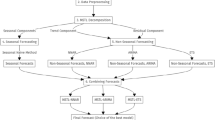Abstract
Forecasting is the process of making value predictions given historical samples of the observed variable. In some cases, there are missing points in the series because of problems in the collector device such as connectivity, maintenance, or meteorological factors. In addition, time series would exhibit a chaotic behavior, which makes the prediction task harder. This paper proposes a technique that uses an Artificial Neural Network and k-Nearest Neighbors for reconstructing and forecasting an incomplete and chaotic time series. The approach was tested with different wind speed series collected at five different locations in the state of Michoacán, Mexico. Forecasting results with and without reconstruction were compared, they show that it is not necessary to reconstruct series with few missing values; but, the forecasting improves significantly by reconstructing series with more than 7% of missing values.











Similar content being viewed by others
Explore related subjects
Discover the latest articles and news from researchers in related subjects, suggested using machine learning.References
Barber C, Bockhorst J, Roebber P (2010) Auto-regressive HMM inference with incomplete data for short-horizon wind forecasting. In: Lafferty JD, Williams CKI, Shawe-Taylor J, Zemel RS, Culotta A (eds) Advances in neural information processing systems, pp 136–144
Barbounis TG, Theocharis JB, Alexiadis MC, Dokopoulos PS (2006) Long-term wind speed and power forecasting using local recurrent neural network models. IEEE Trans Energy Convers 21(1):273–284
Chang WY (2013a) Comparison of three short term wind power forecasting methods. In: Gan B, Gan Y, Yu Y (eds) Advances in applied materials and electronics engineering II, advanced materials research, vol 684. Trans Tech Publications, Zürich, pp 671–675. https://doi.org/10.4028/www.scientific.net/AMR.684.671
Chang W-Y (2013b) An RBF neural network combined with ols algorithm and genetic algorithm for short-term wind power forecasting. J Appl Math 2013:9. https://doi.org/10.1155/2013/971389
Chang WY (2013c) Short-term wind power forecasting using the enhanced particle swarm optimization based hybrid method. Energies 6(9):4879–4896. https://doi.org/10.3390/en6094879. http://www.mdpi.com/1996-1073/6/9/4879
Chang WY (2014) A literature review of wind forecasting methods. J Power Energy Eng 2(4):161–168
Dongmei Z, Yuchen Z, Xu Z (2011) Research on wind power forecasting in wind farms. In: Power engineering and automation conference (PEAM), 2011 IEEE, vol 1, pp 175–178. IEEE
Erdem E, Shi J (2011) ARMA based approaches for forecasting the tuple of wind speed and direction. Appl Energy 88(4):1405–1414
Flores J, Loaeza R, Rodríguez H, Cadenas E (2009) Wind speed forecasting using a hybrid neural-evolutive approach. In: MICAI 2009: advances in artificial intelligence, pp 600–609
Flores JJ, Graff M, Rodriguez H (2012) Evolutive design of ARMA and ANN models for time series forecasting. Renew Energy 44:225–230
Junger W, De Leon AP (2015) Imputation of missing data in time series for air pollutants. Atmos Environ 102:96–104
Lange M, Focken U (2008) New developments in wind energy forecasting. In: 2008 IEEE power and energy society general meeting-conversion and delivery of electrical energy in the 21st century
Liu T, Wei H, Zhang K (2018) Wind power prediction with missing data using Gaussian process regression and multiple imputation. Appl Soft Comput 71:905–916
Mao Y, Shaoshuai W (2016) A review of wind power forecasting & prediction. In: 2016 International conference on probabilistic methods applied to power systems (PMAPS). IEEE, pp 1–7
Piwko D, Jordan G (2010) The economic value of day-ahead wind forecasts for power grid operations. In: 2010 UWIG workshop on wind forecasting
REN21, Hasan R, Mekhilef S, Seyedmahmoudian M, Horan B, Jana J (2017) Renewables 2017: global status report. Renew Sustain Energy Rev 72:1065–1080
Troyanskaya O, Cantor M, Sherlock G, Brown P, Hastie T, Tibshirani R, Botstein D, Altman RB (2001) Missing value estimation methods for DNA microarrays. Bioinformatics 17(6):520–525
Wang H, Wang G, Li G, Peng J, Liu Y (2016) Deep belief network based deterministic and probabilistic wind speed forecasting approach. Appl Energy 182:80–93
Wang X, Guo P, Huang X (2011) A review of wind power forecasting models. Energy Procedia 12:770–778
Wolf A, Swift JB, Swinney HL, Vastano JA (1985) Determining Lyapunov exponents from a time series. Phys D Nonlinear Phenom 16(3):285–317
Wolfram S (1996) Mathematica. Cambridge University Press, Cambridge
Yadav A, Sahu K (2017) Wind forecasting using artificial neural networks: a survey and taxonomy. Int J Res Sci Eng 3:148–155
Yozgatligil C, Aslan S, Iyigun C, Batmaz I (2013) Comparison of missing value imputation methods in time series: the case of turkish meteorological data. Theoretical and Applied Climatology 112(1):143–167
Zhao X, Wang S, Li T (2011) Review of evaluation criteria and main methods of wind power forecasting. Energy Procedia 12:761–769
Acknowledgements
Hector Rodriguez has received a Grant (6258.17p) by Tecnológico Nacional de México (TECNM).
Author information
Authors and Affiliations
Corresponding author
Ethics declarations
Conflict of interest
The authors declare that they have no conflict of interest.
Ethical approval
This article does not contain any studies with human participants or animals performed by any of the authors.
Additional information
Communicated by V. Loia.
Publisher's Note
Springer Nature remains neutral with regard to jurisdictional claims in published maps and institutional affiliations.
Rights and permissions
About this article
Cite this article
Rodriguez, H., Flores, J.J., Morales, L.A. et al. Forecasting from incomplete and chaotic wind speed data. Soft Comput 23, 10119–10127 (2019). https://doi.org/10.1007/s00500-018-3566-2
Published:
Issue Date:
DOI: https://doi.org/10.1007/s00500-018-3566-2




